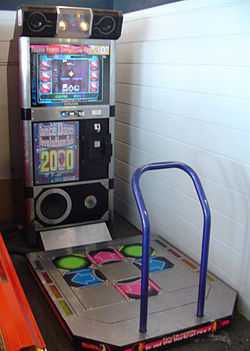Dance Dance Revolution Solo 2000
| Dance Dance Revolution Solo 2000 | |
|---|---|
 | |
| Developer(s) | Konami |
| Publisher(s) | Konami |
| Distributor(s) | Konami |
| Series | Dance Dance Revolution Bemani |
| Engine | Solo 2000 |
| Platform(s) | Arcade |
| Release date(s) | |
| Genre(s) | Music, Exercise |
| Mode(s) | Single-player, 4x Multiplayer |
| Distribution | CD-ROM |
| Cabinet | Custom |
| Arcade system | Bemani System 573 Solo |
| CPU | R3000A 32 bit RISC processor |
| Sound | PlayStation SPU |
| Display | 29" CRT (Raster, 256x224 & 740x480) |
Dance Dance Revolution Solo 2000 (ダンスダンスレボリューションソロ2000 Dansu Dansu Reboryūshonsoro Tsū Sauzando) is the second special one-player version of the Dance Dance Revolution series of music video games. It was released as an arcade game by Konami on December 16, 1999. Although only officially released in Japan, arcade units exist worldwide. DDR Solo 2000 features 36 songs, 20 of which are new to Dance Dance Revolution.
Gameplay
The core gameplay of DDR Solo 2000 is the same as the previous Dance Dance Revolution games but with the addition of two extra arrows on the top corners of the pad. The game can be played with only 3 panels, the traditional 4 panel, or 6 panel. Although it is normally played solo, up to 4 machines can be linked together. In addition, new "Nonstop Megamixes" were added, featuring a club style "truly" nonstop mix of several songs. As with long versions in Dance Dance Revolution 5thMIX, they cost 2 "chips" to play (stages remaining are represented by gold poker chips). A few songs on Solo 2000 contain jumps consisting of more than 2 panels, however these usually involve the left/right and upleft/upright pairs, meaning that they can be done easily with the feet, and are not technically handplants as implemented by In the Groove.
Scoring is completely score based as typical for 4th Mix era games, with 500 points earned per Perfect, 300 per Great, and 100 per Good, with jumps counting as double. Bonuses are also added for the longest combo made (length x 300 points) and the longest chain of Perfects (length x 100 points).
Songs
Notable songs from this version include:
- DROP OUT: the first DDR song to have a consistent BPM over 200. The steps run at 260 BPM, twice the speed of the actual music. The main problem areas on Heavy difficulty are the two sets of 1/4 jumps near the beginning of the song, and the long stream of 1/8 notes near the end. The low framerate of pre-5th Mix games made this song especially difficult to sight-read.
- Nonstop Megamixes: Nonstop Megamixes contain 3 songs mixed together into one long song, and cost two stages to play. The concept did not carry over to other arcade versions until Dance Dance Revolution X, which features 5 different nonstop mixes known as Xmixes. Long versions of select songs in general were featured in Dance Dance Revolution 5th Mix
Soundtrack
A combined soundtrack for both solo versions of DDR was released by Toshiba-EMI under their Dancemania dance music brand. It contains 35 tracks from the game and all 9 megamixes.
Censorship
Solo 2000 was encumbered by a local controversy over content at an arcade in the United States.
In 2002, a local arcade in San Diego, California removed a Solo 2000 machine after Jennifer Stoefen and several members of the local "Youth Advocacy Coalition" complained that the background movies of selected songs contained images that could promote drug and alcohol abuse, such as a scantily clad nurse and pills in "I'm Alive" and alcoholic drinks appearing in "Club Tropicana". The machine was replaced by a mix which did not contain the imagery.[1]
References
- ↑ "Teens get mad over video; it's removed". Retrieved 2008-01-20.
External links
- Dance Dance Revolution Solo 2000 official website (Japanese)
- Dancemania (Japanese)
| ||||||||||||||||||||||||||||||||||||||||||